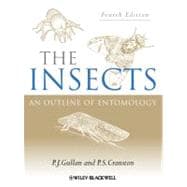This established, popular textbook provides a stimulating and comprehensive introduction to the insects, the animals that represent over half of the planet's biological diversity.
In this new fourth edition, the authors introduce the key features of insect structure, function, behavior, ecology and classification, placed within the latest ideas on insect evolution. Much of the book is organized around major biological themes - living on the ground, in water, on plants, in colonies, and as predators, parasites/parasitoids and prey.
A strong evolutionary theme is maintained throughout. The ever-growing economic importance of insects is emphasized in new boxes on insect pests, and in chapters on medical and veterinary entomology, and pest management. Updated 'taxoboxes' provide concise information on all aspects of each of the 27 major groupings (orders) of insects.
Key Features:
-All chapters thoroughly updated with the latest results from international studies
-Accompanying website with downloadable illustrations and links to video clips
-All chapters to include new text boxes of topical issues and studies
-Major revision of systematic and taxonomy chapter
-Still beautifully illustrated with more new illustrations from the artist, Karina McInnes
A companion resources site is available at www.wiley.com/go/gullan/insects. This site includes:
-Copies of the figures from the book for downloading, along with a PDF of the captions.
-Colour versions of key figures from the book
-A list of useful web links for each chapter, selected by the author.
The authors maintain the tradition of clarity and conciseness set by earlier editions, and the text is illustrated profusely with specially commissioned hand-drawn figures. The illustrations and the informative text aim to encourage the scientific study of insects, either as a vocation or as a hobby. The book is intended as the principal text for students studying entomology, as well as a reference text for undergraduate and graduate courses in fields of ecology, agriculture, fisheries and forestry, palaeontology, zoology, and medical and veterinary science.








